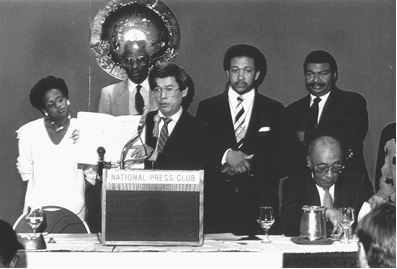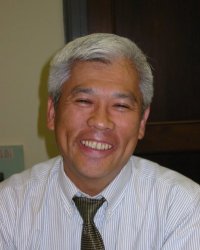AANHPI Heritage Month: Coming Full Circle on Environmental Justice
For Asian American, Native Hawaiian, and Pacific Islander Heritage Month, I have been asked to reflect on how I, a Chinese American born in Taiwan and raised in New York City, came to make Environmental Justice the central focus of my life’s work. This is a reasonable question. When I started to work on the intersecting issues of race, poverty, and the environment, the issue did not even have a name.
Coming of age during the tumultuous 1960s and 1970s, I was influenced greatly by the African American struggle for civil rights and racial justice. Like many Asian Americans, I struggled to understand my racial/ethnic identity in the United States. The universal truths embodied in the writings of Dr. Martin Luther King Jr. and others profoundly shaped my aspirations, thinking, and values.

I started writing about the link between race, poverty, and environment in the late 1970s. In 1982 I saw the connection play out in real life, and it was life changing. I traveled to Warren County, North Carolina to show solidarity with predominantly Black residents protesting the siting of a polychlorinated biphenyl (PCB) hazardous waste landfill. More than 500 people were arrested as protesters lay in front of trucks carrying PCB-laden waste oil. Throughout the protests, I sensed the potential for transformative societal change.
Because of Warren County, I went to work for the United Church of Christ Commission for Racial Justice and did groundbreaking work that gave environmental justice a name and helped propel it onto the national stage. By writing the landmark 1987 Toxic Wastes and Race report (pdf), I brought the weight of empirical evidence to support the idea of environmental racism. By organizing the historic 1991 First National People of Color Environmental Leadership Summit, I helped to coalesce a national environmental justice movement.
This summit strongly demonstrated that communities of color were already providing powerful leadership on environmental issues, including three transcendent Asian American, Native Hawaiian, and Pacific Islander voices:
- Senator Jeton Anjain organized the evacuation of his Marshall Islands homeland, Rongelap, contaminated by the United States’ 1954 hydrogen bomb tests.
- Mililani Trask worked for Native Hawaiian sovereignty and the return of the state-managed lands legally entitled to Native Hawaiians.
- Young Hi Shin co-founded Asian Immigrant Women Advocates to fight for workers’ rights in the San Francisco Bay Area’s garment, hotel, home care, and other low-wage industries.
These actions created a framework to empower and lift-up the voices of all overburdened communities to sustain their pursuit of environmental justice. As a result, EPA’s Office of Environmental Justice was created in 1992, working to address the disproportionately adverse human health and environmental impacts in overburdened communities. Echoing these concerns, in 1994, President Clinton issued Executive Order 12898, recognizing the need for federal focus on environmental justice.

AANHPI advocates realized the need to better organize around environmental justice, which resulted in the creation of the Asian Pacific Environmental Network (APEN). To sum up the APEN’s first two decades, former APEN director Roger Kim and Occidental College professor Martha Matsuoka wrote that APEN “illustrates how [AANHPI] communities can help lead the environmental movement in the future. Building on the existing work of community-based organizing and tapping the demographic transition underway is central to any comprehensive strategy to combat climate change, accelerate the development of an equitable clean energy economy, and ensure a livable planet for generations to come.”
Since coming to EPA, I have worked to integrate environmental justice into our Agency’s policies, programs, and activities. Efforts by the Biden-Harris Administration to advance equity are unprecedented. Under Administrator Michael Regan’s leadership, EPA made environmental justice and equity core principles of how we carry out our mission.
- Making environmental justice a central part of it’s the agency’s new Strategic Plan;
- Increasing investments in overburdened communities
- Strengthening civil rights enforcement to hold polluters accountable
- Implementing an Agency Equity Action Plan that addresses cumulative impacts
Today, we are living through a historic moment for environmental justice. We have come full circle – from a time when environmental justice did not have a name to today when it is at the center of the Biden-Harris Administration’s agenda. Having dedicated much time speaking to and mentoring AANHPI students and youth, today represents a historic opportunity for a whole new generation of Asian Americans, Native Hawaiians, and Pacific Islanders to step forward and provide leadership to advance environmental justice for all communities.

About the Author
Charles Lee
Senior Policy Advisor to the Office of Environmental Justice
Office of the Administrator
Charles Lee is a founder of the EJ movement in the United States. He was the principal author of the landmark study Toxic Wastes and Race in the United States, organized the First National People of Color Environmental Leadership Summit, and spearheaded the emergence of federal EJ justice policy. He was a charter member of the National Environmental Justice Advisory Council and chaired its waste committee. Charles served in multiple leadership roles at EPA, including Director of the Office of Environmental Justice and now Senior Policy Advisor to the office.
Editor’s Note: The views expressed here are intended to explain EPA policy. They do not change anyone’s rights or obligations. You may share this article. However, please do not change the title or the content, or remove EPA’s identity as the author. If you do make substantive changes, please do not attribute the edited title or content to EPA or the author.
EPA’s official web site is www.epa.gov. Some links on this page may redirect users from the EPA website to specific content on a non-EPA, third-party site. In doing so, EPA is directing you only to the specific content referenced at the time of publication, not to any other content that may appear on the same webpage or elsewhere on the third-party site, or be added at a later date.
EPA is providing this link for informational purposes only. EPA cannot attest to the accuracy of non-EPA information provided by any third-party sites or any other linked site. EPA does not endorse any non-government websites, companies, internet applications or any policies or information expressed therein.
